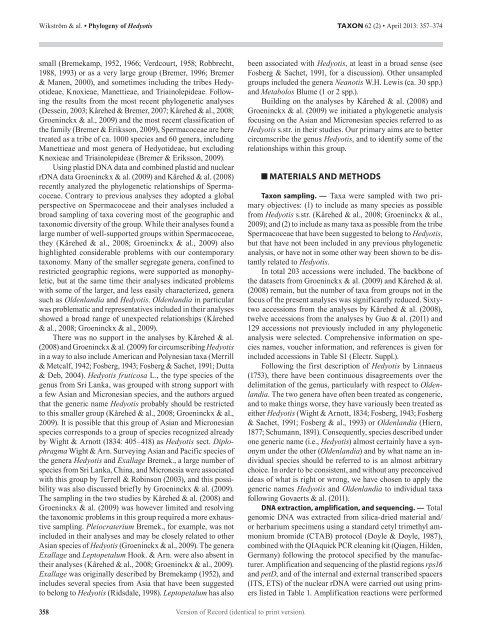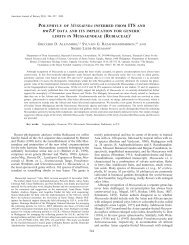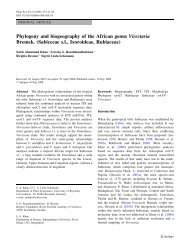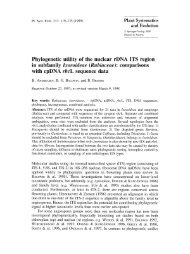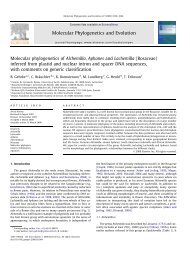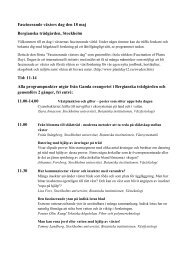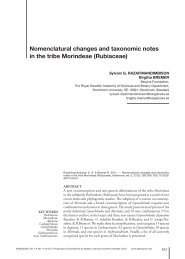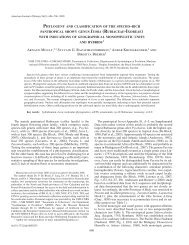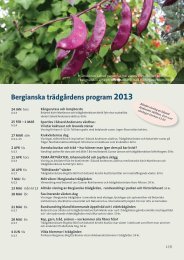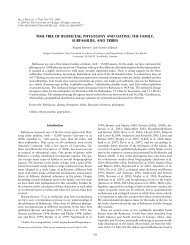Phylogeny of Hedyotis L. (Rubiaceae: Spermacoceae): Redefining a ...
Phylogeny of Hedyotis L. (Rubiaceae: Spermacoceae): Redefining a ...
Phylogeny of Hedyotis L. (Rubiaceae: Spermacoceae): Redefining a ...
Create successful ePaper yourself
Turn your PDF publications into a flip-book with our unique Google optimized e-Paper software.
Wikström & al. • <strong>Phylogeny</strong> <strong>of</strong> <strong>Hedyotis</strong>TAXON 62 (2) • April 2013: 357–374small (Bremekamp, 1952, 1966; Verdcourt, 1958; Robbrecht,1988, 1993) or as a very large group (Bremer, 1996; Bremer& Manen, 2000), and sometimes including the tribes Hedyotideae,Knoxieae, Manettieae, and Triainolepideae. Followingthe results from the most recent phylogenetic analyses(Dessein, 2003; Kårehed & Bremer, 2007; Kårehed & al., 2008;Groeninckx & al., 2009) and the most recent classification <strong>of</strong>the family (Bremer & Eriksson, 2009), <strong>Spermacoceae</strong> are heretreated as a tribe <strong>of</strong> ca. 1000 species and 60 genera, includingManettieae and most genera <strong>of</strong> Hedyotideae, but excludingKnoxieae and Triainolepideae (Bremer & Eriksson, 2009).Using plastid DNA data and combined plastid and nuclearrDNA data Groeninckx & al. (2009) and Kårehed & al. (2008)recently analyzed the phylogenetic relationships <strong>of</strong> <strong>Spermacoceae</strong>.Contrary to previous analyses they adopted a globalperspective on <strong>Spermacoceae</strong> and their analyses included abroad sampling <strong>of</strong> taxa covering most <strong>of</strong> the geographic andtaxonomic diversity <strong>of</strong> the group. While their analyses found alarge number <strong>of</strong> well-supported groups within <strong>Spermacoceae</strong>,they (Kårehed & al., 2008; Groeninckx & al., 2009) alsohighlighted considerable problems with our contemporarytaxonomy. Many <strong>of</strong> the smaller segregate genera, confined torestricted geographic regions, were supported as monophyletic,but at the same time their analyses indicated problemswith some <strong>of</strong> the larger, and less easily characterized, generasuch as Oldenlandia and <strong>Hedyotis</strong>. Oldenlandia in particularwas problematic and representatives included in their analysesshowed a broad range <strong>of</strong> unexpected relationships (Kårehed& al., 2008; Groeninckx & al., 2009).There was no support in the analyses by Kårehed & al.(2008) and Groeninckx & al. (2009) for circumscribing <strong>Hedyotis</strong>in a way to also include American and Polynesian taxa (Merrill& Metcalf, 1942; Fosberg, 1943; Fosberg & Sachet, 1991; Dutta& Deb, 2004). <strong>Hedyotis</strong> fruticosa L., the type species <strong>of</strong> thegenus from Sri Lanka, was grouped with strong support witha few Asian and Micronesian species, and the authors arguedthat the generic name <strong>Hedyotis</strong> probably should be restrictedto this smaller group (Kårehed & al., 2008; Groeninckx & al.,2009). It is possible that this group <strong>of</strong> Asian and Micronesianspecies corresponds to a group <strong>of</strong> species recognized alreadyby Wight & Arnott (1834: 405–418) as <strong>Hedyotis</strong> sect. DiplophragmaWight & Arn. Surveying Asian and Pacific species <strong>of</strong>the genera <strong>Hedyotis</strong> and Exallage Bremek., a large number <strong>of</strong>species from Sri Lanka, China, and Micronesia were associatedwith this group by Terrell & Robinson (2003), and this possibilitywas also discussed briefly by Groeninckx & al. (2009).The sampling in the two studies by Kårehed & al. (2008) andGroeninckx & al. (2009) was however limited and resolvingthe taxonomic problems in this group required a more exhaustivesampling. Pleiocraterium Bremek., for example, was notincluded in their analyses and may be closely related to otherAsian species <strong>of</strong> <strong>Hedyotis</strong> (Groeninckx & al., 2009). The generaExallage and Leptopetalum Hook. & Arn. were also absent intheir analyses (Kårehed & al., 2008; Groeninckx & al., 2009).Exallage was originally described by Bremekamp (1952), andincludes several species from Asia that have been suggestedto belong to <strong>Hedyotis</strong> (Ridsdale, 1998). Leptopetalum has alsobeen associated with <strong>Hedyotis</strong>, at least in a broad sense (seeFosberg & Sachet, 1991, for a discussion). Other unsampledgroups included the genera Neanotis W.H. Lewis (ca. 30 spp.)and Metabolos Blume (1 or 2 spp.).Building on the analyses by Kårehed & al. (2008) andGroeninckx & al. (2009) we initiated a phylogenetic analysisfocusing on the Asian and Micronesian species referred to as<strong>Hedyotis</strong> s.str. in their studies. Our primary aims are to bettercircumscribe the genus <strong>Hedyotis</strong>, and to identify some <strong>of</strong> therelationships within this group.Materials and MethodsTaxon sampling. — Taxa were sampled with two primaryobjectives: (1) to include as many species as possiblefrom <strong>Hedyotis</strong> s.str. (Kårehed & al., 2008; Groeninckx & al.,2009); and (2) to include as many taxa as possible from the tribe<strong>Spermacoceae</strong> that have been suggested to belong to <strong>Hedyotis</strong>,but that have not been included in any previous phylogeneticanalysis, or have not in some other way been shown to be distantlyrelated to <strong>Hedyotis</strong>.In total 203 accessions were included. The backbone <strong>of</strong>the datasets from Groeninckx & al. (2009) and Kårehed & al.(2008) remain, but the number <strong>of</strong> taxa from groups not in thefocus <strong>of</strong> the present analyses was significantly reduced. Sixtytwoaccessions from the analyses by Kårehed & al. (2008),twelve accessions from the analyses by Guo & al. (2011) and129 accessions not previously included in any phylogeneticanalysis were selected. Comprehensive information on speciesnames, voucher information, and references is given forincluded accessions in Table S1 (Electr. Suppl.).Following the first description <strong>of</strong> <strong>Hedyotis</strong> by Linnaeus(1753), there have been continuous disagreements over thedelimitation <strong>of</strong> the genus, particularly with respect to Oldenlandia.The two genera have <strong>of</strong>ten been treated as congeneric,and to make things worse, they have variously been treated aseither <strong>Hedyotis</strong> (Wight & Arnott, 1834; Fosberg, 1943; Fosberg& Sachet, 1991; Fosberg & al., 1993) or Oldenlandia (Hiern,1877; Schumann, 1891). Consequently, species described underone generic name (i.e., <strong>Hedyotis</strong>) almost certainly have a synonymunder the other (Oldenlandia) and by what name an individualspecies should be referred to is an almost arbitrarychoice. In order to be consistent, and without any preconceivedideas <strong>of</strong> what is right or wrong, we have chosen to apply thegeneric names <strong>Hedyotis</strong> and Oldenlandia to individual taxafollowing Govaerts & al. (2011).DNA extraction, amplification, and sequencing. — Totalgenomic DNA was extracted from silica-dried material and/or herbarium specimens using a standard cetyl trimethyl ammoniumbromide (CTAB) protocol (Doyle & Doyle, 1987),combined with the QIAquick PCR cleaning kit (Qiagen, Hilden,Germany) following the protocol specified by the manufacturer.Amplification and sequencing <strong>of</strong> the plastid regions rps16and petD, and <strong>of</strong> the internal and external transcribed spacers(ITS, ETS) <strong>of</strong> the nuclear rDNA were carried out using primerslisted in Table 1. Amplification reactions were performed358 Version <strong>of</strong> Record (identical to print version).


